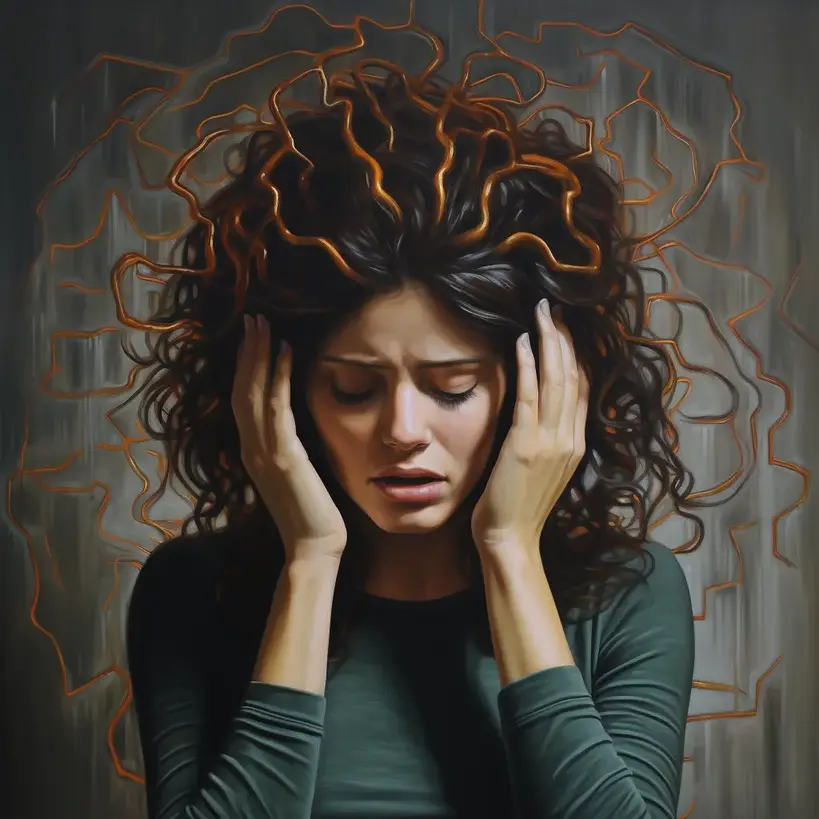The eyes, often dubbed as the ‘windows to the soul,’ serve as our primary tool for observing, connecting with, and interpreting the world around us. These intricate organs allow us to capture the beauty of a sunset, witness the innocent playfulness of a child, and navigate the complex web of human interactions.
However, when someone sleeps with their eyes open, this regular physiological function hints at a more profound, metaphysical phenomenon, drawing a connection between the tangible and the intangible. In this article, we’ll delve into the spiritual nuances associated with sleeping with one’s eyes open and understand its mystical significance.
Contents
I. Introduction to Sleeping with Eyes Open
Sleep, as a phenomenon, has long been regarded as a retreat into the world of dreams, subconscious thoughts, and possibly, the spiritual realm. Historically, the act of closing one’s eyes has symbolized surrender to the unknown, an embrace of the non-physical. However, there’s a curious phenomenon where some individuals sleep with their eyes open.
Sleeping with the eyes open is not merely a quirky habit; it is a recognized medical condition termed Nocturnal Lagophthalmos. Derived from the Greek words “nux” (night) and “lagos” (hare) combined with “ophthalmos” (eye), the term reflects the appearance of the eye resembling that of a hare’s, which often stays alert even during resting phases.
In most cases, Nocturnal Lagophthalmos is caused by factors like facial nerve damage, eyelid deformities, or previous surgical procedures. It can also arise from dehydration or thyroid-related problems. If untreated, it may lead to dryness, irritation, and even potential eye infections due to the eye’s exposure without the protection of the eyelid.
II. The Spiritual Meaning of Sleeping with Eyes Open
Beyond the physiological implications, this phenomenon prompts deeper philosophical and spiritual inquiries: Does it bridge the gap between the physical and the metaphysical? And if so, how?
1. Dual Consciousness
Sleeping with eyes open can be seen as a representation of having a foot in two worlds simultaneously – the conscious and the subconscious. Those who sleep in this manner may be perceived to be more attuned to their inner thoughts and the world around them at the same time.
It is a state where the mind does not fully retreat into the realm of dreams but instead maintains a thread of awareness. This dual consciousness could signify a heightened state of spiritual awareness where one’s soul is both at rest and observant.
2. Enhanced Perception
It is believed by some spiritualists that sleeping with eyes open allows individuals to tap into a deeper level of perception. This means that, while their physical body rests, their spiritual self remains alert and sensitive to the energies and vibrations around them.
Such enhanced perception can also lead to increased intuition, foresight, or even the ability to perceive spiritual entities that exist on different vibrational frequencies.
3. Symbol of Inner Awakening
Just as the Buddha is often depicted with half-closed eyes during meditation, symbolizing a state of deep internal focus yet awareness of the external world, sleeping with eyes open can be a symbol of inner awakening.
It might indicate that the individual is undergoing a spiritual transformation, becoming more attuned to their higher self and the mysteries of the universe.
4. Connection to the Astral Plane
The astral plane is believed to be a dimension of existence parallel to the physical world. Those who sleep with their eyes open might be more adept at astral projection, a phenomenon where the spiritual body separates from the physical body and travels in the astral realm.
Their open eyes could be a portal or connection point between the physical and astral dimensions, allowing for easier access and transition between the two.
5. Unresolved Tensions or Fears
From a more psychological perspective, sleeping with eyes open might indicate unresolved tensions, fears, or traumas. The spirit may be on high alert, even at rest, due to past experiences or deep-seated anxieties. This state can be a call for inner healing and a need to address and release these spiritual blockages to achieve true peace.
6. Connection Between Two Worlds
Eyes open during sleep might symbolize a bridge between the conscious and subconscious realms, or between the physical world and the spiritual or dream world. Such individuals may be seen as mediators, shamans, or even messengers, who have the unique ability to communicate and understand both worlds. Their open eyes during sleep serve as a constant reminder of this dual responsibility and gift.
- Conclusion
While sleeping with eyes open has medical explanations, such as certain neurological conditions or REM sleep behavior disorder, the spiritual interpretations offer a deeper insight into the connection between the physical and metaphysical realms. Whether you view it from a scientific or spiritual perspective, it remains a fascinating phenomenon that prompts us to consider the mysteries of consciousness and existence.
III. Sleeping As A Doorway To The Astral Realm
The idea that sleep serves as a passage to other realms isn’t a new concept. Across various cultures and spiritual traditions, sleep has been revered not just as a physical restorative process, but also as a transcendent experience where the soul, or the consciousness, ventures beyond the confines of the physical body. Central to this belief is the concept of the astral realm, a dimension of existence parallel to our physical world.
a) Understanding the Astral Realm
The astral plane, often described in esoteric teachings, is a non-physical dimension that exists alongside our tangible reality. It is a place where thoughts, emotions, and desires take form, and where time and space behave differently than in our physical world.
When we sleep, our physical bodies undergo a restorative process. The brain shifts through various stages, from light sleep to deep REM (Rapid Eye Movement) stages. It’s during these deeper stages, particularly REM, that most dreaming occurs. While scientific understanding attributes dreams to neural processes, many spiritual traditions believe that dreaming is an instance of the soul or consciousness traveling to other realms, including the astral plane.
b) Astral Projection and Out-of-Body Experiences (OBEs)
Astral projection, or the act of consciously guiding one’s astral body out of the physical form, is a practice familiar to many spiritual traditions. While this can be achieved through meditation and other techniques, sleep naturally predisposes us to this phenomenon:
- Natural Disassociation: During sleep, especially the deeper stages, there’s a natural disassociation between the conscious mind and the physical body. This state is conducive to astral travel as the ties to the physical realm loosen.
- Vivid Dreams as Astral Journeys: Some dreams, particularly those that feel intensely real or lucid, might actually be astral journeys where the dreamer’s consciousness explores the astral realm.
- Encounters with Entities: Some dreamers report interactions with unknown entities, departed loved ones, or guides. These encounters, rather than mere constructs of the subconscious mind, might be genuine interactions in the astral plane.
c) Bridging Physical and Astral Realms
Sleeping with open eyes, a condition medically known as nocturnal lagophthalmos, presents an intriguing physical state. It blurs the traditional boundaries between being fully asleep and completely awake. From a spiritual perspective, this state may symbolize a heightened state of awareness, a readiness to receive insights or a manifestation of being in two worlds simultaneously - the physical and the astral.
- Enhanced Perceptual State: The open-eyed phenomenon could represent a unique state of consciousness, where the barriers between the physical and astral realms are thinner. This state might make it easier for individuals to perceive astral occurrences or to remember astral journeys more vividly upon waking.
- Visual and Spiritual Interface: Physically, open eyes receive visual stimuli even during sleep, although they are not consciously processed. Spiritually, this could signify an openness to receiving impressions or messages from the astral realm, perhaps acting as a conduit for astral energies.
- Vigilance and Readiness: In many spiritual traditions, open eyes are a symbol of watchfulness and readiness. In the context of astral travel, this could imply a readiness of the spirit to embark on or return from astral journeys, signifying more active participation in the astral realm.
The act of sleeping with open eyes may have specific energetic implications. It could signify an inherently higher energy state, a constant flow of energy that keeps the physical and astral channels open simultaneously. This state might create a continuous energetic exchange between the sleeper and the astral realm, possibly influencing their spiritual journey and growth.
IV. Chakras and the Open-Eyed Phenomenon
The chakras, a concept deeply rooted in the yogic traditions of ancient India, are believed to be spinning vortexes of energy spread along the central channel of the body. These energy centers play a pivotal role in regulating various physiological and psychological processes. The phenomenon of sleeping with eyes open, when viewed through the lens of chakras, provides a unique perspective, especially concerning the third eye or the sixth chakra.
a) The Significance of the Sixth Chakra (Third Eye):
Location and Representation: Situated between the eyebrows, the Ajna chakra, commonly known as the third eye, acts as the seat of intuition and higher wisdom. It is considered the bridge between our reason and our inner knowing.
Functions and Attributes:
- Intuition and Insight: The Ajna chakra governs intuitive abilities and insights. A well-balanced third eye chakra allows an individual to tap into the subconscious mind, unveiling deep truths and understandings.
- Perception Beyond the Physical: While our two eyes see the physical world, the third eye perceives the inner realms. It is this chakra that is responsible for dreams, visions, and spiritual experiences.
b) How Sleeping with Open Eyes Might Affect Energy Flow:
Blending of Realities:
- When one sleeps with open eyes, the barriers between the conscious and the subconscious can become blurred. This state might enhance the activity of the Ajna chakra, allowing individuals to perceive realities beyond the ordinary. They might experience vivid dreams or even visions that seem to overlay with the physical world.
Enhanced Intuition:
- The constant engagement of the eyes even during sleep might signify a heightened sensitivity of the third eye chakra. Such individuals might find themselves more attuned to their intuitive abilities, often sensing things before they happen or perceiving deeper truths in everyday situations.
Chakra Imbalance:
- On the flip side, continuously sleeping with open eyes might indicate an overactive Ajna chakra. Symptoms could include feeling spaced out, overly analytical thinking, or being trapped in an excessively dreamy state without being grounded in reality. This could potentially hinder the free flow of energy, especially if the root chakra, responsible for grounding, is not equally active.
Energetic Influence on Surroundings:
- Energy constantly emanates from our chakras, interacting with our surroundings. Those sleeping with open eyes might exert a unique energetic influence on their environment, especially during the night when energies are subtler. Their open-eyed state might act as a beacon, attracting specific energies or entities, which could be either beneficial or disruptive.
Conclusion:
The practice of sleeping with eyes open, when interpreted through the framework of the chakras, unveils profound spiritual and energetic implications. The third eye, being the chakra of perception, seems intrinsically linked to this phenomenon. As with many spiritual practices and experiences, awareness, balance, and grounding are essential. While the open-eyed state might enhance certain perceptions, ensuring the balanced flow of energy throughout all chakras will optimize the experience.
V. Meditative States and Sleeping Patterns
Meditation, with its varied techniques and ancient roots, has always been revered as a pathway to inner peace, enlightenment, and self-awareness. On the flip side, sleep, though a daily routine, is a profound process of rejuvenation and subconscious exploration. The interplay between these two states, especially when coupled with the phenomenon of sleeping with eyes open, offers a fascinating perspective on human consciousness.
a) The Thin Line Between Meditation and Sleep
Both sleep and meditation are restorative processes that the body and mind undergo to heal, rejuvenate, and process information. The primary difference lies in the level of consciousness. In traditional sleep, consciousness is diminished, and we drift into dreams or deep slumber. In meditation, on the other hand, there’s an elevated level of awareness, even in its deepest states.
However, there is a gray area where meditation and sleep can overlap. Yogis, for instance, practice a form of meditation known as “Yoga Nidra” or “Yogic Sleep.” Here, the practitioner lies down and enters a state of deep relaxation, teetering on the edge of sleep, but remains aware of their surroundings. This blurring of lines between meditation and sleep hints at the immense potential the human mind possesses in accessing altered states of consciousness.
b) How Open Eyes Might Indicate a Deeper State of Trance
Sleeping with eyes open could, in certain spiritual contexts, signify a deep trance or meditative state where the physical and spiritual worlds merge. In some shamanic traditions, a trance state with open eyes is viewed as the shaman’s ability to see into the spirit world while still being anchored in the physical realm. The open eyes, therefore, act as a bridge between the seen and the unseen, the known and the unknown.
Additionally, in Zen Buddhism, there’s a meditation practice known as ‘Zazen’ or ‘sitting meditation,’ where the practitioner keeps their eyes slightly open. The opened eyes in Zazen are meant to ground the practitioner in the present moment and the physical space around them, while also delving into the depths of their mind.
Sleeping with eyes open, in these spiritual contexts, is not just a physiological occurrence. It is a profound state of being that represents a merger of the inner and outer worlds, a unification of the conscious and subconscious realms. It symbolizes a heightened state of awareness where the individual is in touch with the vastness of existence while being rooted in the physical dimension.
VI. Historical Context of Sleeping with Open Eyes
The act of sleeping with eyes open has fascinated societies across the ages, leaving a trail of myth, speculation, and reverence. To truly understand this phenomenon, it’s crucial to trace its historical context, from ancient societies to more modern times.
1. Ancient Civilizations:
- Egyptians: The ancient Egyptians believed in the power of the eyes as symbolic gateways. They had gods with eyes that never blinked, seeing all realms simultaneously. Though not explicitly about sleeping with eyes open, the significance they attached to the eyes suggested an understanding of continuous vigilance and connection to other realms.
- Greeks: The Greek mythological figure Argus Panoptes, a giant with a hundred eyes, was said to never sleep with all his eyes at once. Some always remained open, watching. This can be seen as a representation of perpetual vigilance.
2. Tribal and Indigenous Societies:
- Guardianship and Vigilance: In some tribal communities, those who could sleep with eyes open were seen as protectors or guardians. Their ever-watchful eyes during sleep acted as a deterrent to potential threats, be it animals or rival tribes.
- Spiritual Seers: In certain cultures, such individuals were believed to be in touch with the spirit world even while they slept. Their open eyes during rest symbolized a bridge between the physical and spiritual realms, and they were often regarded as seers or shamans.
3. Medieval and Renaissance Periods:
- Witchcraft and Omens: During the medieval ages, especially in Europe, any deviation from the ‘norm’ was often met with suspicion. Sleeping with open eyes was sometimes considered a sign of witchcraft or being under a spell. People with such tendencies were often viewed with suspicion or awe.
- Sign of Royalty or Divinity: Conversely, in some societies, especially in Asia, sleeping with open eyes was considered a sign of divine connection or even royalty. Emperors or spiritual leaders exhibiting such traits were thought to be in touch with the gods even in their sleep.
4. Modern Interpretations in Literature and Folklore:
- Symbol of Alertness: Characters described as sleeping with eyes open in modern literature are often portrayed as ever-alert, battle-ready, or possessing a heightened sense of their surroundings. This portrayal is especially common in war narratives or tales of espionage.
- Mystical Abilities: As in ancient times, even modern folklore and fictional tales associate sleeping with open eyes with mysticism. Characters with this trait might be bestowed with visions or an ability to foresee events.
Final Thought
The phenomenon of sleeping with one’s eyes open extends far beyond the realm of mere physical occurrence. From dual awareness to the seamless blend of meditation and sleep, this act symbolizes a myriad of profound experiences.
In our quest to understand the spiritual significance of this phenomenon, we are reminded of the expansive nature of human experience. The body may rest, but the spirit remains ever vigilant, ever curious, seeking connection, meaning, and enlightenment.
Whether viewed through the lens of science, spirituality, or folklore, sleeping with eyes open serves as a beautiful and intriguing reminder of the depths of the human soul and its eternal quest for understanding.


